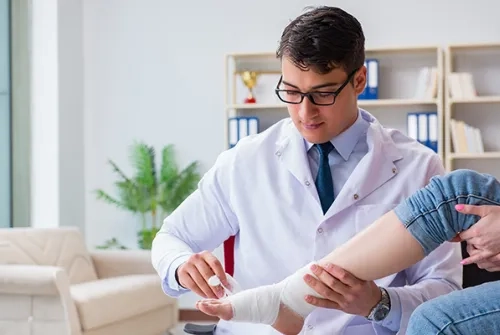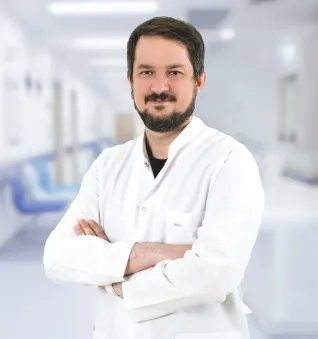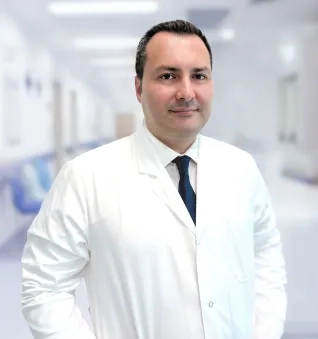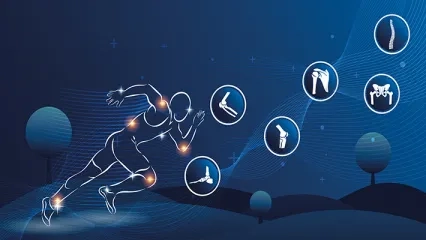Alo Yeditepe
Alo Yeditepe
Myths About Fractures
Fractures are one of the most common orthopedic problems that can occur after any trauma, no matter how minor or major. These accidents can sometimes be a simple fall or sometimes larger injuries such as traffic accidents. However, Yeditepe University Hospitals Orthopedics and Traumatology Specialist said that fractures must be treated regardless of the cause and that fractures can heal with the right treatment, but it should not be forgotten that fractures are serious injuries. He pointed out that there is some misinformation about this common problem.
"If You Can Move It, There Is No Fracture."
Correction: Yeditepe University Hospitals Orthopedics and Traumatology Specialist said that although the loss of movement is one of the symptoms of fracture, depending on the pain threshold of the person, people who feel little pain after trauma may cause damage: "Our body restricts our movements by using the pain mechanism in case of fracture. Another reason for the restriction of movement develops due to deterioration in bone structure. Especially in intra-articular or comminuted fractures, loss of movement develops due to loss of integrity of the bone structure. The term "fracture" is used to refer to undifferentiated fractures. Although the limitation of movement and pain complaints are more common in comminuted fractures, they can also occur in fractures."
Pointing out that this misinformation may have negative effects, our specialist said, "An undifferentiated fracture can often be treated with non-surgical methods. On the other hand, patients may lose this chance if they are ignored, loaded or moved."
"In Case of a Fracture, There Must Be Pain, If There Is No Pain, There Is No Fracture."
Correction: Although pain is one of the main symptoms of a fracture, our specialist said that the presence or absence of pain is not a criterion for fracture and gave the following information: "Although it may seem confusing, this is related to the pain threshold of the person. People with a high pain threshold can ignore the pain in simple fractures. Low levels of pain may also occur in failure fractures that develop due to chronic trauma, such as stress fractures."
Stating that moving without pain or with mild pain without being aware of the fracture can also cause a delay in treatment, our specialist continued his words as follows; "In cases where pain is interpreted as low and movement is continued, the amount of separation in the fracture may increase. This may require the application of more complex treatment methods in patients who can be easily treated. In addition, the movement must be restricted for the fracture to heal. As you move, the healing period will be prolonged."
"Finger Fractures Heal Naturally, No Need to See a Doctor."
Correction: Our specialist said that deformity, limitation of movement and difficulty in grasping may occur in finger fractures that cannot be treated appropriately and therefore must be treated, and continued his words as follows:
"Functional success after union in fractures depends on the location of the fracture and the level of separation. In finger fractures, the amount of angulation and whether the fracture is in the joint or not are of critical importance. Especially intra-articular fractures or finger fractures that show separation can lead to grip difficulty, limitation of movement and cosmetic deformities. Treatment results are more favorable in toe fractures compared to fingers. However, it should not be forgotten that treatment is required in the presence of a suspected fracture."
Pointing out that the age of the patient is also very important in finger fractures, our Yeditepe University Hospitals Orthopedics and Traumatology specialist said, "Especially in children, unlike adults, there are growth nuclei. Pediatric fractures are especially important as injuries to the growth nucleus can cause deformities in the long term."
"Broken Bone Becomes Stronger Than Before"
Correction: Stating that this is also a misconception, our specialist said, "There is no relationship between the strength of the bone and the state of the fusion after the fracture. Therefore, the broken bone will not be stronger than before."
"Only the Fracture Area Has Pain"
Correction: Our specialist said that there is a loss of integrity in the bone tissue with trauma, but in addition, the energy that causes the fracture will also damage the soft tissue, "Therefore, pain can be felt not only in the fracture area but also in a wider area."
This content was prepared by Yeditepe University Hospitals Medical Editorial Board.
”
See Also
- What are Hip Joint Diseases? Causes and Treatment
- Robotic Hip Replacement Surgery
- Knuckle Cracking Can Be Dangerous When It Becomes a Habit!
- What is Hallux Rigidus (Stiff Big Toe/Toe Arthritis)? Symptoms and Treatment
- What is Hallux Valgus (Bunion)? How is it Treated?
- What is a Bone Tumor? Bone Tumor Symptoms
- Meniscus and Cartilage Transplantation Can Be Done at the Same Time
- What is Crooked Leg? Can Crooked Legs Be Treated?
- What Causes Shoulder Dislocation? Shoulder Dislocation Treatment
- Wrist Pain Causes and Treatment
- Ergonomics in Automobiles Prevents Accidents
- Don't Underestimate Bone Pain That Doesn't Make You Sleep and Doesn't Relieve With Medication
- Joint Pain and Causes of Joint Pain
- Walking and Returning to Social Life After Knee Replacement Surgery
- What Are the Advantages of Robotic Knee Replacement Surgery?
- Robotic Knee Prosthesis Surgery
- Why Does Ankle Pain Occur? What Is the Treatment?
- The Usage Area of Robotic Surgery Expands in Orthopedic Surgeries
- Higher Risk of Anterior Cruciate Ligament and Ankle Injury in Female Athletes
- Patients Who Undergo Joint Replacement Surgery Can Stand Up and Walk the Next Day
- Spinal Fractures
- Big Toes Can Be A Big Problem!
- What is Synovitis in Joints?
- Hip Osteoarthritis and Hip Prosthesis
- Hip Impingement Syndrome
- What is the Future of Treating Cartilage Problems?
- Not Only Athletes Suffer from Meniscus Tears!
- Is Cartilage Damage More Common in Those Who Run for Long Periods?
- Beware If Your Shoulder Or Neck Pain Lasts Longer Than Two Days After Swimming!
- Mistakes While Swimming Can Cause Shoulder Pain
- Vitamin D Deficiency May Be The Cause Of Your Joint Pain
- The First Onset of Pain in Cartilage Damage in the Knee Should Not Be Overlooked
- Have Your Baby Take Their First Steps in Good Health
- Heavy School Bags Can Cause Pain in the Lower Back, Shoulders, and Hands!
- Sports Injuries
- Cartilage Transplantation from Donor Has Been Started to Perform in Turkey
- Working From Home Increases Waist and Neck Problems
- He Walked Out Of The Hospital Where He Entered On Crutches
- First Cartilage Transplant from a Donor
- Pay Attention to the Pain That Occurs in the Front Part of Your Knees While Playing Sports!
- 8 Common Misconceptions About Sports Injuries
- Young Patient Who Could Not Walk Due to Cartilage Damage Recovered With Cartilage Transplantation
- Knee Arthritis
- Knee Pain
- Crunching in the Kneecap May Be a Sign of Calcification
- Injured Athletes Can Return To Sports With Cartilage Transplant
- Treatment of Knee Arthrosis Varies According to the Person
- A Lack of Attention to Sports Injuries in Children May Affect Their Development
Alo Yeditepe







